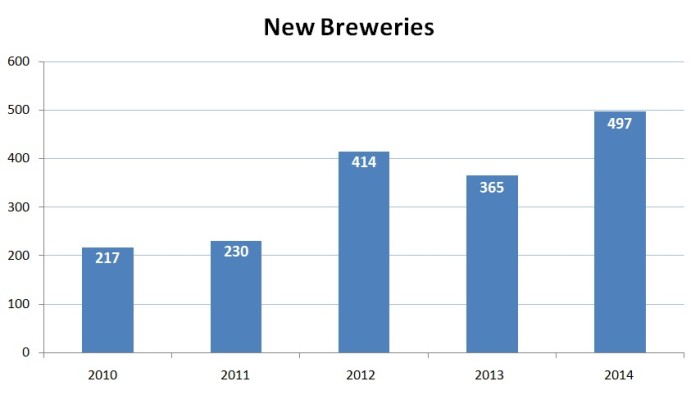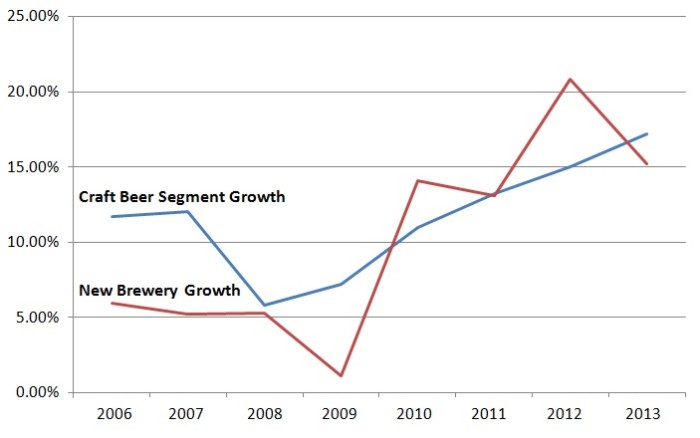Spotting Beer Trends in 2014 and Beyond
Most years, when looked at closely, yield only small, soon-forgotten trends. The economy usually rises or falls a bit, but not dramatically. The stock market fluctuates. Various industries trend up or down. But infrequently, big changes do happen: tech stocks around the turn of the century; the economy in 2008. Many people, looking at the numbers in 2014, wonder if it wasn’t the start of one of those moments. Three big trends marked the year:
– Roughly 500 breweries opened in 2014, and 2,000 more are in planning stages
– The craft beer segment as defined by the Brewers Association was growing in double digits again this year (by 18% at the half-year mark)
– Several high-profile “craft breweries” (a term with increasingly muddy provenance) were acquired in part or wholly by large multinational companies
We won’t know the final numbers for months, but these do suggest the appearance of a bubble. Since 2009, the number of breweries has more than doubled in the United States, and brewery growth is spiking (all numbers in this post come from the Brewers Association).
Bucking the appearance of a bubble, though, is the second trend—growth in the craft beer segment. Even as Americans continue to drink less beer each year—and especially mass-market lagers—they drink way more in the craft market segment. So when you look at the growth of new breweries and the growth of the market, it doesn’t look quite as startling.
Paul Krugman, who is more reliable than me on these matters, describes a bubble as “a situation in which asset prices appear to be based on implausible or inconsistent views about the future.” A brewery bubble would be a situation in which the overall capacity of all the craft breweries were radically higher than the actual number of barrels required by the market. What we appear to be looking at is a market responding to growth by adding new capacity to meet demand.
These two first trends would in turn explain the final trend we saw this year, of multinational companies acquiring craft breweries. The craft beer segment currently accounts for about 10% of the beer sold in the United States. In order to increase sales, the big breweries need to jump from the market segment that’s shrinking to the one that’s growing. Taken together, these three trends strongly suggest that growth in the craft market segment in beer is still healthy. Maybe this was a ho-hum year after all.
But what does this mean looking forward? Just because the craft beer segment has been growing in double digits for a decade doesn’t mean it will continue to do so forever. One data point I’m watching is the growth of breweries relative to brewpubs. The United States could accommodate an enormous number of brewpubs—10,000 easily. (They would account for only 5 million barrels of total volume.) Brewpubs function at the neighborhood level, like restaurants and coffee shops, and can serve their customers directly. Production breweries are different. They confront a bottleneck at the retail level: there are only so many tap handles and linear feet on supermarket shelves. And here, things are getting dicey.
Five years ago, there were 576 production breweries in the United States and 1,020 brewpubs; production breweries constituted just a third of the total (great interactive graph with the numbers here). Much of the growth since, however, has been among production breweries. At the end of 2013, there were a whopping 1,531 production breweries and only 1,237 brewpubs. Production breweries are now a majority (55%) in the United States. Moreover, that period coincides with some huge brewery expansions by mid- and large-sized craft breweries. It’s easy to envision a future where the market for beer is robust and growing but there are nevertheless a number of brewery failures.
As we plunge into the new year, I’ll be looking less at the baseline number for new brewery openings but at the mix of which type of breweries are opening. I’ll also be watching the growth figures to see if there’s any softening in the craft beer segment. At some point, math dictates that growth will slow. Once that happens, brewery openings will need to slow as well, or we could see a bubble forming. My bet is that big changes are still a few years out, but I’ll watch closely to see if there are any signs of them in 2015.
Oh, I’m also expecting a ton of exceptional beer will get made in 2015. Whatever else happens, that makes me bullish on the new year.
Read more posts from The Beer Bible Blog.
Jeff Alworth is the author of the forthcoming book, The Beer Bible (Workman, 2015). Follow him on Twitter or find him at his blog, Beervana.

Leave a Reply